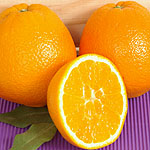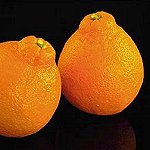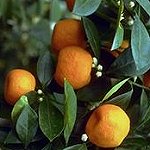|
|
|
Orange,Tangerine & Mandarin Fruit Facts Page Information
|
Availability by variety
|
 Orange,Tangerine and Mandarin, common name for citrus fruit of several trees.
Different varieties include the sweet orange, the sour orange, and the
mandarin orange, or tangerine.
Orange,Tangerine and Mandarin, common name for citrus fruit of several trees.
Different varieties include the sweet orange, the sour orange, and the
mandarin orange, or tangerine.
The Navel Orange, so
named for their "belly button" at the blossom end, were discovered
in the 1820's as an unusual growth on a Salata tree in Salvador, Brazil, but
are believed to have originated in China. It's a large seedless fruit,
that's juicy and sweet with thick skins that make it easy to peel and section
for eating. The Cara Cara resembles a regular Navel, but the inside is a
gorgeous deep salmon color. The taste is sweet and juicy. This unique variety
originated at the Hacienda Cara Cara in Venezuela in the early 1970s, and are
a new addition to the California, San Joaquin Valley.
Valencia, first named Excelsior, is considered the worlds most important orange.
Believed to be of Spanish origin, the variety actually became of interest in
the Azores and is almost certainly of old Portuguese origin. The rind is
thin and leathery, the interior bright orange, with a high juice content and
sweet flavor. Valencias typically have 2-4 seeds per fruit.
 Tangerine is the common name for a variety of Mandarin orange. The
mandarin orange is native to southeastern Asia and has been widely cultivated
in orange-growing regions of the world. The tangerine resembles the orange
but is smaller and oblate in shape and has a more pungent odor, a thinner
rind, and sections that may be readily separated. It has a food value
comparable to that of the orange, but the fruit is more delicate and subject
to damage in handling.
Tangerine is the common name for a variety of Mandarin orange. The
mandarin orange is native to southeastern Asia and has been widely cultivated
in orange-growing regions of the world. The tangerine resembles the orange
but is smaller and oblate in shape and has a more pungent odor, a thinner
rind, and sections that may be readily separated. It has a food value
comparable to that of the orange, but the fruit is more delicate and subject
to damage in handling.
 The Satsuma Mandarin is believed to have originated in Japan probably
in the mid-sixth century A.D. It acquired its name in 1878 by the wife of
Gen. Van Valkenberg, the U.S. Minister to Japan. Satsuma's have a mild sweet
flavor, full of juice, virtually no seeds, pebbly in texture and the interior
is a bright orange. This fruit peels and segments easily.
The Satsuma Mandarin is believed to have originated in Japan probably
in the mid-sixth century A.D. It acquired its name in 1878 by the wife of
Gen. Van Valkenberg, the U.S. Minister to Japan. Satsuma's have a mild sweet
flavor, full of juice, virtually no seeds, pebbly in texture and the interior
is a bright orange. This fruit peels and segments easily.
The fruit of all these varieties is technically a hesperidium, a kind of berry.
It consists of several easily separated carpels, or sections, each containing
several seeds and many juice cells, covered by a leathery exocarp, or skin,
containing numerous oil glands. Orange trees are evergreens, seldom exceeding
9 m (30 ft) in height. The leaves are oval and glossy and the flowers are
white and fragrant. Three essential oils are obtained from oranges: oil of
orange, obtained from the rind of the fruit and used principally as a flavoring
agent; oil of petigrain, obtained from the leaves and twigs and used in
perfumery; and oil of neroli, obtained from the blossoms and used in flavorings
and perfumes.
In the United States the principal orange-producing states are Florida,
California, Texas, and Arizona. From 1991 to 1992 the yield of oranges
in the United States was about 10 million metric tons. The principal crops
of the western growers consist of the Valencia and the Bahia, or Washington
navel orange, imported from Bahia, Brazil, in 1870, and developed in Washington,
D.C., by the U.S. Department of Agriculture. The navel orange is a seedless
orange, with medium-thick rind, in which a second small, or abortive, orange
grows. A variety of the Washington navel orange is the principal orange product
of Texas.
The sour orange is cultivated to a limited extent for
marmalade and to provide rootstock for less vigorous strains. About 20 percent
of the total crop of oranges is sold as whole fruit; the remainder is used in
preparing frozen and canned orange juice, extracts, and preserves.
Basic Nutritional Facts:
· Low fat
· Saturated fat-free
· Sodium-free
· Cholesterol-free
· A good source of vitamin C
Detailed nutritional informatin can be found by searching the
USDA Nutritional Database
. Enter "Orange" (no quotes) as the keyword and select the link and report
of interest.
Scientific classification:
Oranges belong to the genus Citrus, of the family Rutaceae. The sweet orange
is classified as Citrus sinensis; the sour, or Seville, orange as
Citrus aurantium; and the mandarin orange, or tangerine, as
Citrus reticulata.
|
|